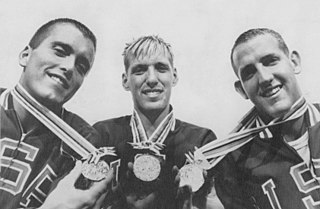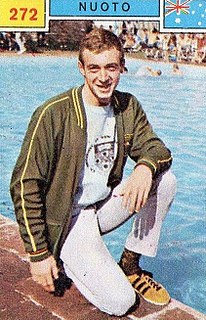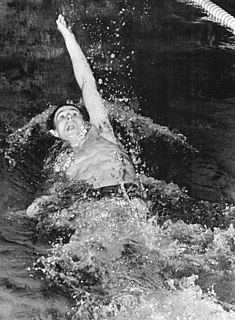The men's 200 metre butterfly event at the 1972 Olympic Games took place August 28. This swimming event used the butterfly stroke. Because an Olympic-size swimming pool is 50 metres long, this race consisted of four lengths of the pool.
The men's 200 metre butterfly event at the 1956 Olympic Games took place on 30 November and 1 December. This swimming event used the butterfly stroke. Because an Olympic-size swimming pool is 50 metres long, this race consisted of four lengths of the pool. This was the first time that the butterfly stroke had appeared in the Olympic Games.

The men's 200 metre butterfly event at the 1960 Olympic Games took place on August 31 and September 2 in Rome, Italy. This swimming event used the butterfly stroke. This race consisted of four lengths of the Stadio Olympico del Nuoto, a 50m Olympic size swimming pool.

The men's 100 metre freestyle event at the 1964 Olympic Games took place between October 11 and 12. There were 66 competitors from 33 nations. Nations were again able to bring up to three swimmers each after a one-Games limit of two in 1960. The event was won by Don Schollander of the United States, the nation's first victory in the event since 1952 and eighth overall. Great Britain and the United Team of Germany both earned their first medal in the men's 100 metre freestyle.
The men's 400 metre freestyle event at the 1964 Olympic Games took place between October 14 and 15. This swimming event used freestyle swimming, which means that the method of the stroke is not regulated. Nearly all swimmers use the front crawl or a variant of that stroke. Because an Olympic size swimming pool is 50 metres long, this race consisted of eight lengths of the pool.
The men's 1500 metre freestyle event at the 1964 Olympic Games took place between October 16 and 17. This swimming event used freestyle swimming, which means that the method of the stroke is not regulated. Nearly all swimmers use the front crawl or a variant of that stroke. Because an Olympic-size swimming pool is 50 metres long, this race consisted of 30 lengths of the pool.

The men's 200 metre backstroke event at the 1964 Summer Olympics took place between October 11 and 13. There were 34 competitors from 21 nations, with each nation having up to 3 swimmers. The medals were swept by the United States, with Jed Graef, Gary Dilley, and Bob Bennett taking gold, silver, and bronze respectively.
The men's 200 metre breaststroke event at the 1964 Summer Olympics took place between October 13 and October 15. This swimming event used the breaststroke. Because an Olympic-size swimming pool is 50 metres long, this race consisted of four lengths of the pool.
The men's 400 metre individual medley event at the 1964 Summer Olympics took place on 12–14 October. This swimming event used medley swimming. Because an Olympic size swimming pool is 50 metres long, this race consisted of eight lengths of the pool. The first two lengths were swum using the butterfly stroke, the second pair with the backstroke, the third pair of lengths in breaststroke, and the final two were freestyle. Unlike other events using freestyle, swimmers could not use butterfly, backstroke, or breaststroke for the freestyle leg; most swimmers use the front crawl in freestyle events.
The men's 4×100 metre medley relay event at the 1964 Olympic Games took place on October 15 (qualification) and October 16 (final). This swimming event uses medley swimming as a relay. Because an Olympic size swimming pool is 50 metres long, each of the four swimmers completed two lengths of the pool, each using a different stroke. The first on each team used the backstroke, the second used the breaststroke, the third used the butterfly stroke, and the final swimmer used freestyle.
The women's 100 metre freestyle event at the 1964 Olympic Games took place between October 12 and 13. This swimming event used freestyle swimming, which means that the method of the stroke is not regulated. Nearly all swimmers use the front crawl or a variant of that stroke. Because an Olympic-size swimming pool is 50 metres long, this race consisted of two lengths of the pool.
The women's 100 metre butterfly event at the 1964 Olympic Games took place on October 14 and October 16. This swimming event used the butterfly stroke. Because an Olympic size swimming pool is 50 metres long, this race consisted of two lengths of the pool.

The men's 100 metre freestyle event at the 1968 Olympic Games took place between 18 and 19 October. There were 64 competitors from 34 nations. Nations had been limited to three swimmers each since the 1924 Games. The event was won by Michael Wenden of Australia, the nation's third victory in four Games. Americans Ken Walsh and Mark Spitz took silver and bronze, respectively.

The men's 200 metre freestyle event at the 1968 Olympic Games took place on 24 October at the Alberca Olímpica Francisco Márquez. It was the third time the event was held, returning for the first time since 1904. There were 57 competitors from 26 nations, with each nation having up to three swimmers. The event was won by Michael Wenden of Australia, the nation's second victory in the event ; Australia extended its podium streak in the event to three Games over 68 years. It was Wenden's second gold medal of the Games, completing a 100/200 free double. Americans Don Schollander and John Nelson took silver and bronze, respectively.

The men's 200 metre backstroke event at the 1968 Summer Olympics took place on 25 October at the Alberca Olímpica Francisco Márquez. There were 30 competitors from 21 nations, with each nation having up to three swimmers. The event was won by Roland Matthes of East Germany, the second gold medal for a German swimmer after Ernst Hoppenberg won in 1900. Matthes completed the backstroke double in the first Games both events were held, with Olympic record times in both. The United States, which had swept the podium in 1964, finished in the next three places behind Matthes: Mitch Ivey took silver, Jack Horsley bronze, and Gary Hall Sr. 4th.
The men's 100 metre butterfly event at the 1968 Olympic Games took place between 20 and 21 October. This swimming event used the butterfly stroke. Because an Olympic size swimming pool is 50 metres long, this race consisted of two lengths of the pool.
The men's 200 metre butterfly event at the 1968 Olympic Games took place 24 October. This swimming event used the butterfly stroke. Because an Olympic-size swimming pool is 50 metres long, this race consisted of four lengths of the pool.
The men's 200 metre individual medley event at the 1968 Olympic Games took place between 19 and 20 October. This swimming event used medley swimming. Because an Olympic size swimming pool is 50 metres long, this race consisted of four lengths of the pool. The first length was swum using the butterfly stroke, the second with the backstroke, the third length in breaststroke, and the fourth freestyle. Unlike other events using freestyle, swimmers could not use butterfly, backstroke, or breaststroke for the freestyle leg; most swimmers use the front crawl in freestyle events anyway.
The women's 200 metre butterfly event at the 1968 Olympic Games took place 24 October. This swimming event used the butterfly stroke. Because an Olympic size swimming pool is 50 metres long, this race consisted of four lengths of the pool. This was the first time for this event for the women swimmers.
The men's 200 metre individual medley event at the 1972 Olympic Games took place September 3. This swimming event used medley swimming. Because an Olympic size swimming pool is 50 metres long, this race consisted of four lengths of the pool. The first length was swum using the butterfly stroke, the second with the backstroke, the third length in breaststroke, and the fourth freestyle. Unlike other events using freestyle, swimmers could not use butterfly, backstroke, or breaststroke for the freestyle leg; most swimmers use the front crawl in freestyle events anyway.





